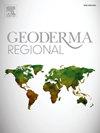一个用于阿根廷潘帕斯农业决策的地下水位波动的简单模型
IF 3.3
2区 农林科学
Q2 SOIL SCIENCE
引用次数: 0
摘要
浅层和波动的地下水位给世界各地的农业区带来了重大的挑战和机遇。本研究探讨了地下水位波动、土壤类型、潜在蒸散和降雨之间复杂的相互作用,以期建立一个用户友好的地下水位动态预测模型。我们的目的是校准和验证地下水位波动(WTF)模型,并应用该模型评估阿根廷潘帕斯草原不同土壤类型和气候条件下的各种农学情景。方法方法包括从整个研究区域的67个地点汇编一个广泛的数据库。在不同的气候条件、土壤类型和初始地下水位下,对三个具有代表性的地点进行了模拟。校正和评价结果的均方根误差分别为34.6和36.4 cm,平均均方根误差分别为19%和21.3%;表现非常好。初始地下水位较浅的湿润气候情景表明发生内涝的风险较高,而较深的初始地下水位表明发生内涝的风险较低,作物可利用的水分较多。Argiudoll土壤对气候条件的变化表现出更大的敏感性,而Haplustoll和Hapludoll土壤对气候条件的响应较小。总的来说,WTF模型为农民提供了一个有价值的工具,使他们能够在水管理和作物规划方面做出明智的决定。通过将地下水位波动的复杂动态简化为易于理解的形式,该模型提高了农民适应不断变化的环境条件的能力,从而支持阿根廷潘帕斯草原的可持续农业做法。本文章由计算机程序翻译,如有差异,请以英文原文为准。
A simple model for water table fluctuations for agronomic decision making in the Argentinian Pampas
The shallow and fluctuating water table present significant challenges and opportunities for agricultural regions worldwide. This study explores the intricate interplay between water table fluctuations, soil type, potential evapotranspiration and rainfall in order to develop a user-friendly model for predicting water table dynamics. Our aim was to calibrate and validate the Water Table Fluctuation (WTF) model and the application of the WTF model assessing various agronomic scenarios across diverse soil types and climate conditions within the Argentinean Pampas. The methodological approach involved compiling an extensive database from 67 sites across the study area. Simulations were conducted for three representative sites under varying climatic conditions, soil types, and initial water table depths. The calibration and evaluation results showed an RMSE of 34.6 and 36.4 cm and an average RRMSE of 19 and 21.3 %, respectively; indicating very good performance. Wet climate scenarios with shallow initial water table depths indicated a high risk of waterlogging, whereas deeper initial depths showed reduced risk and increased usability of water for crops. The Argiudoll soil showed greater sensitivity to changes in the climate conditions, while Haplustoll and Hapludoll soils were less responsive. Overall, the WTF model provides a valuable tool for farmers, enabling them to make informed decisions about water management and crop planning. By simplifying the complex dynamics of water table fluctuations into an accessible format, the model enhances the capacity of farmers to adapt to changing environmental conditions, thereby supporting sustainable agricultural practices in the Argentinean Pampas.
求助全文
通过发布文献求助,成功后即可免费获取论文全文。
去求助
来源期刊

Geoderma Regional
Agricultural and Biological Sciences-Soil Science
CiteScore
6.10
自引率
7.30%
发文量
122
审稿时长
76 days
期刊介绍:
Global issues require studies and solutions on national and regional levels. Geoderma Regional focuses on studies that increase understanding and advance our scientific knowledge of soils in all regions of the world. The journal embraces every aspect of soil science and welcomes reviews of regional progress.
 求助内容:
求助内容: 应助结果提醒方式:
应助结果提醒方式:


